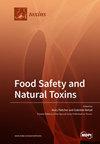海洋植物毒素 Azaspiracid-2 引起的人肠道上皮细胞 Caco-2 细胞凋亡和氧化应激
IF 3.9
3区 医学
Q2 FOOD SCIENCE & TECHNOLOGY
引用次数: 0
摘要
当人类食用被亲脂性聚醚藻毒素(如氮杂螺螨毒素(AZAs))污染的海产品时,毒素主要在小肠中浸出和吸收,可能会造成肠道损伤。本研究利用人体肠道上皮细胞 Caco-2 来研究氮杂吡啶-2(AZA-2)对人体肠道上皮细胞的不良影响。研究了细胞活力、凋亡、氧化损伤和线粒体超微结构,并应用核糖核酸序列(RNA-seq)分析探讨了AZA-2对Caco-2细胞毒性的潜在机制。结果表明,AZA-2能明显降低Caco-2细胞的增殖,且呈浓度依赖性,48 h的EC50为12.65 nmol L-1。AZA-2 能以剂量依赖性方式诱导 Caco-2 细胞凋亡。在暴露于 AZA-2 的 Caco-2 细胞中观察到线粒体明显肿胀、嵴解体、膜破裂和自噬。Caco-2 细胞暴露于 1 nmol L-1 和 10 nmol L-1 的 AZA-2 48 小时后,活性氧(ROS)和丙二醛(MDA)含量显著增加。转录组分析表明,与细胞氧化损伤和脂质代谢相关的 KEGG 通路受到了影响,主要包括有丝分裂、氧化磷酸化、胆固醇代谢、维生素消化吸收、胆汁分泌和过氧化物酶体增殖激活受体信号通路。AZA-2 对 Caco-2 细胞的细胞毒性作用可能与 ROS 介导的线粒体细胞自噬和凋亡有关。这项研究的结果加深了人们对AZA-2对Caco-2细胞的细胞毒性和分子机制的认识,对保护人类健康具有重要意义。本文章由计算机程序翻译,如有差异,请以英文原文为准。
Apoptosis and Oxidative Stress in Human Intestinal Epithelial Caco-2 Cells Caused by Marine Phycotoxin Azaspiracid-2
When humans consume seafood contaminated by lipophilic polyether phycotoxins, such as azaspiracids (AZAs), the toxins are mainly leached and absorbed in the small intestine, potentially causing intestinal damage. In this study, human intestinal epithelial Caco-2 cells were used to investigate the adverse effects of azaspiracid-2 (AZA-2) on human intestinal epithelial cells. Cell viability, apoptosis, oxidative damage and mitochondrial ultrastructure were investigated, and ribonucleic acid sequence (RNA-seq) analysis was applied to explore the potential mechanisms of AZA-2 toxicity to Caco-2 cells. Results showed that AZA-2 significantly reduced the proliferation of Caco-2 cells in a concentration-dependent response, and the 48 h EC50 of AZA-2 was 12.65 nmol L−1. AZA-2 can induce apoptosis in Caco-2 cells in a dose-dependent manner. Visible mitochondrial swelling, cristae disintegration, membrane rupture and autophagy were observed in Caco-2 cells exposed to AZA-2. Reactive oxygen species (ROS) and malondialdehyde (MDA) content were significantly increased in Caco-2 cells after 48 h of exposure to 1 and 10 nmol L−1 of AZA-2. Transcriptome analysis showed that KEGG pathways related to cellular oxidative damage and lipid metabolism were affected, mainly including mitophagy, oxidative phosphorylation, cholesterol metabolism, vitamin digestion and absorption, bile secretion and the peroxisome proliferator-activated receptor signaling pathway. The cytotoxic effects of AZA-2 on Caco-2 cells may be associated with ROS-mediated autophagy and apoptosis in mitochondrial cells. Results of this study improve understanding of the cytotoxicity and molecular mechanisms of AZA-2 on Caco-2 cells, which is significant for protecting human health.
求助全文
通过发布文献求助,成功后即可免费获取论文全文。
去求助
来源期刊

Toxins
TOXICOLOGY-
CiteScore
7.50
自引率
16.70%
发文量
765
审稿时长
16.24 days
期刊介绍:
Toxins (ISSN 2072-6651) is an international, peer-reviewed open access journal which provides an advanced forum for studies related to toxins and toxinology. It publishes reviews, regular research papers and short communications. Our aim is to encourage scientists to publish their experimental and theoretical results in as much detail as possible. There is no restriction on the length of the papers. The full experimental details must be provided so that the results can be reproduced.
 求助内容:
求助内容: 应助结果提醒方式:
应助结果提醒方式:


